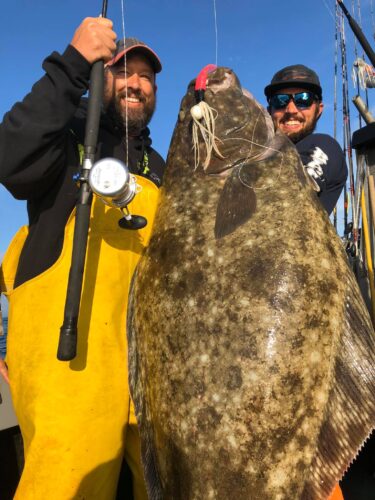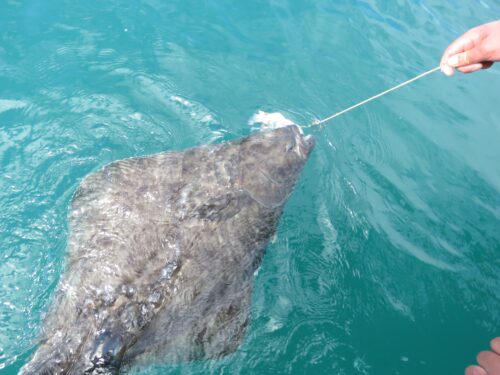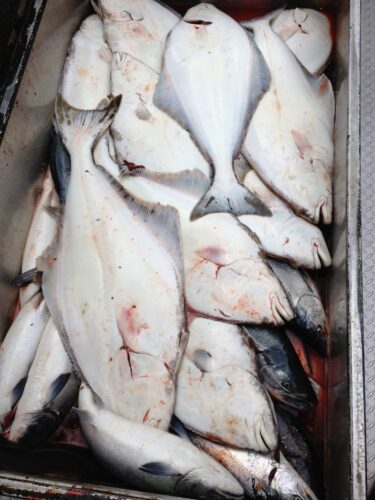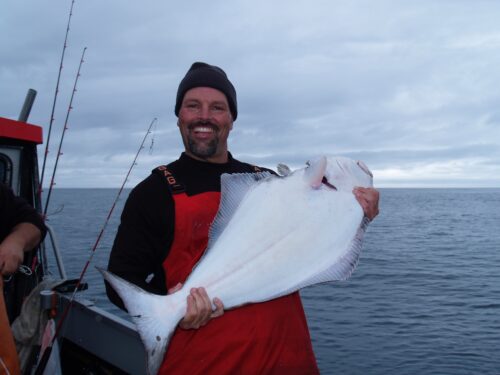
An Alaskan Halibut How-to Guide
The following appears in the November issue of Alaska Sporting Journal:

BY CAL KELLOGG
It was the fourth and final day of my annual Cook Inlet fishing odyssey. It had been a great trip so far – we’d caught silver, sockeye and pink salmon, limits of big black rockfish, limits of lingcod ranging from 30- to 50-plus pounds and lots of Pacific halibut. We hadn’t landed any flatties beyond the 100-pound mark, but quality fish in the 30- to 70-pound class had kept us busy by day and sore by night.
There was zero wind and the surface of the inlet looked like a sheet of black glass beneath the overcast sky. We’d been pulling a parade of keeper and sub-keeper halibut off the bottom, 180 feet beneath the boat.
When we’d started dropping herring baits teamed with 4-pound sinkers, the outgoing tide had been running strong, but now 90 minutes later the tide was ebbing and would soon go slack before the flood began.
“Reel up, Cal,” Capt. Steve Smith of Captain Steve’s Fishing Lodge instructed. “I want you to try something different.”
A couple minutes later he traded my stout baitfishing rod for a rod with a lighter tip and armed with a 16-ounce jighead. It was the same jigging gear we’d used at the lingcod grounds. A huge white grub was pinned on the jig, but it was pretty chewed up and missing its tail.
“Drop it to the bottom, lift it up a couple feet and drop it down. When you feel a tick, set the hook and reel,” Steve said.
I asked if they’d hit the jig without a tail.
“They actually seem to like the ones with missing tails better. You aren’t trying to imitate anything in particular. It’s the movement that triggers the strike,” Steve told me.
Lift, drop, repeat … Lift, drop, repeat. I’d been jigging for a minute or two when the first strike came. It consisted of three sharp taps. I froze for a second, then set the hook and missed.
Steve is one of those skippers who seems to have eyes in the back of his head. I didn’t think he was watching, but he’d seen everything.
“That was a little fish, but you’ve gotta be quicker on the hookset,” he told me. “Don’t hesitate and when you hook up, get on the reel immediately.”
I was ready for the next strike and drilled the hook home. I could tell it was a small fish immediately because I’d felt it move up in the water when I set the hook. I cranked the 20-pounder up, Steve released it with a practiced flick of the hook and I was jigging again in short order.
When the third strike came, I could tell instantly it was a substantial fish. There was a single hard tug and the rod tip started to pull down against the weight of a halibut intent on swimming off with its prize.
I was running on autopilot. I drilled the hook home with a short, hard jab and immediately started cranking on the reel. The fish was heavy and determined to stay on the bottom. Initially, all my cranking of the reel did nothing but draw the rod down into a satisfying bow.
For a few minutes the fight was a stalemate, but in the end the fish was no match for the resilient backbone of the rod. When the handsome halibut came to the boat, I worked it into position just below the surface and Steve drove the gaff home. It wasn’t a 100-plus-pound barn door, but it was a perfect eating-size fish that weighed 45 to 50 pounds and provided many memorable meals back at my California home.

DON’T FORGET THE BAIT METHOD
Before we get into halibut jigging and its benefits, let’s consider the tried- and-true bait fishing approach just for comparison purposes, and to give anyone reading this who has yet to target Pacific halibut in Alaskan waters a feel for what Alaskan-style halibut fishing is all about.
The day-in, day-out most consistent way to hook Pacific halibut is by soaking bait. The typical bait rig looks like this: The angler employs a stout rod fitted with a large reel spooled with 100-plus-pound braided line. On the business end of the rig, a large weight – weighing from 2 to 8 pounds – is attached, usually in a manner that allows the weight to slide to some degree. Below the weight is a leader, generally constructed of paracord and sporting two 16/0 circle hooks. No, that wasn’t a typo. Sixteen-aught hooks are the standard, and for reference they are about the size of your palm! Herring chunks are the most common bait, but salmon heads, octopus and even poultry guts are used at times.
Once your hooks are baited, you lower the rig to the bottom, but you just don’t sit and wait for a bite. To discourage trash fish, spread scent and make your baits more noticeable to the halibut, you lift the rig approximately twice per minute and set it back down on the bottom.
A bite is telegraphed up the line as a series of taps. Since you’re using circle hooks, a standard hookset won’t work. Instead, you need to let the halibut gnaw on the bait as you stand statue-still holding the rod.
When the rod tip starts pulling down, you elevate the rod tip slightly while steadily cranking the reel. If you execute the operation correctly, the hook will be drawn into the corner of the halibut’s mouth, and you’ll be hooked up.
I’d like to tell you that once the hooks sink home you’ve got the fish, but such is not the case. It is absolutely critical that you keep the line tight during the entire fight. Given slackline, halibut – particularly large halibut – have an uncanny ability to shake a circle hook free.
The bait fishing method I’ve just described is rewarding and produces halibut of all sizes. It’s also physically demanding and there is a definite learning curve when it comes to executing the proper hookset and fighting the fish.

THE JIGGING WAY
In contrast, jigging is a breath of fresh air, and for a few reasons. First and foremost, jigging tackle is either somewhat or a lot lighter than the pool- cue rods and huge reels used when soaking bait.
Second, while there is still technique required to sink the steel into a halibut while jigging, a standard hookset is employed that most people find easier than executing the lift-and-reel method used while soaking bait. A lot of people have a hard time holding still from 15 to 30 seconds while a halibut chomps on their bait.
With the jig, when you feel a bite, swing immediately. The challenge with jigging is instantly reeling when you swing. A common mistake you see goes like this: The angler gets a bite; angler then swings and then looks up and stares at the rod tip before reeling. That hesitation will cost you a fish, particularly with big fish.
When a big halibut gets stuck, often its first reaction is a headshake. The jig hanging out of their mouth gives them tremendous leverage and given slack, it’s often bye-bye fish and chips.

HEAVY AND LIGHT
There are two types of halibut jigging employed in Alaska. There is heavy jigging, which is focused on hooking big halibut, and light jigging, focused on hooking medium and small halibut – say, fish in the 15- to 40-pound class.
Heavy jigging uses the same heavy, typically 1-pound jigheads used for tempting lingcod. The most common offering pinned on the head is a jumbo white Kalin’s Grub, but in recent years several different octopus imitations have gained popularity.
Speaking of lingcod fishing, very often big 60- to 150-pound halibut are a bycatch of ling jiggers. While lingcod inhabit craggy, rocky reefs, there are flat spots and areas of packed gravel punctuating the reefs. Big halibut will post up in these locations, and when your jig dances by, wham-o, fish on!
When you incidentally stick a halibut while jigging for lings, the boat is typically drifting. When heavy jigging at traditional sand- and gravel- bottom halibut areas, such as fabled Cook Inlet, the boat is almost always anchored and there are generally other anglers on the boat soaking bait. Having a jig or two in the water when fishing bait benefits everyone because it adds more movement and vibration to your spread, plus it draws more fish to the boat.
This is a point many people don’t grasp about halibut fishing while anchored. The skipper sets up in a promising location and halibut are typically scattered over a broad area. The scent and movement of your baits, combined with the thrashing of hooked fish causes the halibut to move to your boat. It’s like ringing a dinner bell. This is why boats with physically fit, attentive anglers typically outfish crews of more complacent anglers fishing in virtually the same location.

JIGGING PRESENTATION
Back to the jigs. When jigging from an anchored boat, the added movement and sound created by the jigs acts as a powerful enticement that can pull in halibut from a good distance away.
The presentation is simple. During slack-water periods, you can drop straight down below the boat and vertical jig, lifting and dropping the jig just like I described in the beginning of this piece.
If the current is moving, the presentation is pretty much the same, but you’ll be positioned at the transom of the boat because the current is going to carry the jig away from you. You’ll still be executing the lift-and-drop technique, but your jig may be 100 to 200 feet beyond the boat.
Light jigging is exceptionally fun and is generally done from a drifting boat. If I lived in Alaska and had my own boat, light jigging would be my method of choice for putting halibut filets into the cooler. In fact, my first-ever Alaskan halibut came as a bycatch while working a 3-ounce Gibbs Minnow for silver salmon. While the 30-pounder looked huge to me, the skipper quickly released it and admonished me for dropping down too deep.
“That halibut is too small to keep,” he said.
I haven’t done a lot of light jigging from charter boats or guide boats, because those operations are generally focused on hooking big halibut, not playing with little 30- and 40-pounders. However, there are times after you’ve been chasing salmon or lingcod all day and the skipper wants to pad the fish box with limits of keeper halibut. This is when the steelhead- and striped-bass- weight rods armed with metal jigs in the 3- to 6-ounce class come out.
Typically, the skipper will line up a drift over a shallow sandbar in 25 to 50 feet of water. You drop your jig to the bottom, yo-yo and reel it up 10 feet or so, drop back down and repeat. Generally, your jig will get hammered immediately and soon the fish box will be full of chicken-sized halibut. These fish provide exceptional table fare and on light gear the fight is incredible.

BAIT, THEN JIGS
If you are an Alaska resident who is going for halibut for the first time, or if you’re a visitor from the Lower 48 who has never targeted Alaskan halibut, there is a good chance the rest of the folks on the boat will have zero halibut experience just like you.
I suggest you start out fishing bait and do exactly what the skipper tells you to do, but as you gain confidence and get a few halibut under your belt, ask the skipper if it would be appropriate to drop a jig. Do that, and if the situation is conducive to jigging, you might find yourself tempting your fish on a 1-pound jig rather than lifting, dropping and cranking up 4-pound weights that look like miniature loaves of bread.
At the end of the day, regardless of how you hook your Pacific halibut, you’ll be taking home some of the finest meat available to the North American angler. ASJ



